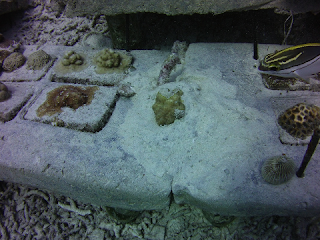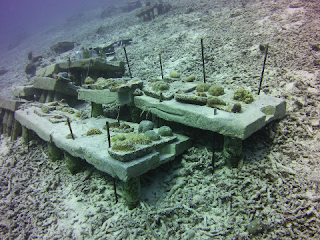Step reef 2.0
 |
| Initial design |
Itchy turtle making a mess!
Step reef re- design
One of the first things we noticed was that, in general, the
trial step reefs which were larger , were more stable. This lead to the idea of
interlocking each individual block with the one both its left and right, this
in effect makes every layer of the step reef one large stable block. This is
achieved by leaving gaps between the individual blocks, with the plan to initially cable tie them and then cement
these once the blocks are in place under the water. Massive and encrusting corals will be put in
the unset cement with the hope that they would grow to envelop the two blocks,
creating a biological adhesion that will only become stronger over time.
The next area we chose to strengthen was between layers. A
simple and effect method of using recycled stakes to hold each step in place
was used. There by removing the possibility of shallower step reefs rolling
downhill over deeper step reefs.
Step reef from every angle
interlocking layers
When the step reef is in place we add biscuits (basically a coral plant pot) from our coral nursery.
As you can tell from the picture below, he step reefs are
strong enough to support the weight of our step reef primary engineer, Kit! Hopefully our new step reefs trials will be totally successful,. [blog posts on this topic to come]. I personally cannot wait to start deploying these.
Nice and Sturdy
For more information, please check our website or e-mail info@tracc-borneo.org
The main website is at http://tracc-borneo.org
Check out our posts on our activities
on fb tracc.borneo
on twitter tracc_borneo
on google + tracc







